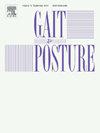基于imu的儿童早期精细运动发展特征的线性和非线性度量
IF 2.2
3区 医学
Q3 NEUROSCIENCES
引用次数: 0
摘要
背景精细运动能力评估在神经心理学检查中对发育缺陷的识别起着关键作用。放砖(PB)测试通过测量完成时间来评估精细运动能力。最近,使用可穿戴惯性传感器进行PB测试,以可靠和客观的性能测量(即周期和放置时间)补充其标准评估。这项工作旨在扩展允许定量精细运动评估和调查精细运动轨迹的指标,从3到7岁。研究问题:基于imu的线性和非线性指标如何提供对儿童早期精细运动发展的洞察?方法对126例正常发育儿童(3 ~ 7岁)进行双手腕惯性传感器PB测试。在角速度上计算时间参数(周期和放置时间)及其变异性(四分位数范围,短期和长期变异性,通过poincar本文章由计算机程序翻译,如有差异,请以英文原文为准。
IMU-based linear and nonlinear metrics for the characterization of fine motor development in early childhood
Background
Fine motor competence assessment plays a pivotal role in neuropsychological examinations for the identification of developmental deficits. The Placing Bricks (PB) test evaluates fine motor competence relying on the measurement of time to completion. Recently, the PB test was instrumented using wearable inertial sensors to complement its standard assessment with reliable and objective measures of performance (i.e., cycle and placing durations). This work aims at extending the metrics that allow a quantitative fine motor assessment and at investigating fine motor trajectory from 3 to 7 years of age.
Research question
How can IMU-based linear and nonlinear metrics provide insight into fine motor development during early childhood?
Methods
126 typically developing children (3–7 years) performed the PB test with inertial sensors on both wrists. Temporal parameters (Cycle and Placing durations), their variability (interquartile range, short-term and long-term variability, via Poincaré plots) were calculated on angular velocities, and nonlinear metrics (multiscale entropy and recurrence quantification analysis) on acceleration data. The effects of age, handedness, and sex were analysed: parameters showing age effects were visualized using a polar plot with age reference bands.
Results
Results revealed differences related to age and hand dominance: cycle and placing durations as well as variability decreased, while multiscale entropy increased and recurrence decreased with age and when using the dominant hand. Both age and the use of the dominant hand are associated with shorter, less variable cycles, with more complex movement patterns, reflecting more mature fine motor control.
Significance
The patterns highlight specific characteristics of fine motor maturation, showing in which domain changes occur and towards which direction. The proposed IMU-based approach effectively described fine motor control development in the analysed population.
求助全文
通过发布文献求助,成功后即可免费获取论文全文。
去求助
来源期刊

Gait & posture
医学-神经科学
CiteScore
4.70
自引率
12.50%
发文量
616
审稿时长
6 months
期刊介绍:
Gait & Posture is a vehicle for the publication of up-to-date basic and clinical research on all aspects of locomotion and balance.
The topics covered include: Techniques for the measurement of gait and posture, and the standardization of results presentation; Studies of normal and pathological gait; Treatment of gait and postural abnormalities; Biomechanical and theoretical approaches to gait and posture; Mathematical models of joint and muscle mechanics; Neurological and musculoskeletal function in gait and posture; The evolution of upright posture and bipedal locomotion; Adaptations of carrying loads, walking on uneven surfaces, climbing stairs etc; spinal biomechanics only if they are directly related to gait and/or posture and are of general interest to our readers; The effect of aging and development on gait and posture; Psychological and cultural aspects of gait; Patient education.
 求助内容:
求助内容: 应助结果提醒方式:
应助结果提醒方式:


